DRY FLOWER ARRANGEMENT
The art of making arrangements with dried flowers and leaves was a flourishing craft as early as the seventeenth century in England and America. But now it has passed from the hobby stage to big business in many countries. In recent years, there has developed a trend to fragrance a mixture of flowers for keeping in rooms, kitchens, toilets etc. This is known as ‘Potpourri’, wherein our living environment is made fragrant with natural items.
Advantages of dried arrangement over fresh flowers
- It is not dependent on season or weather if once good materials are collected.
- It lasts almost indefinitely.
- It helps the individuals to improve their skill in design by affording time to study composition and to correct mistakes.
- Dried arrangements are certainly time savers as they can be made by conveniently in advance and then enjoyed as needed.
Materials for dried arrangement
The materials usually employed for dried arrangement can be grouped into three categories as follows.
- Cultivated flowers and vegetable including seed, pods, vines and grains.
- Naturally available materials like flowers, seed pods, fern leaves, certain weeds and grasses.
- Pods, cones, capsules, fruits, branches, leaves, berries and flowers of broadleaved evergreen trees and shrubs.
|
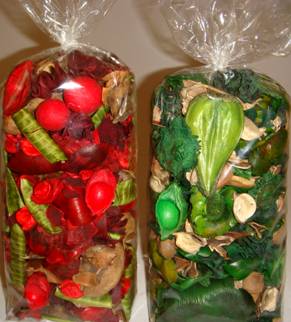 |
| Potpourri |
|
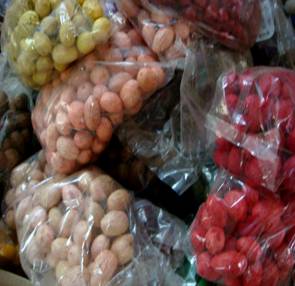
|
| Dried pods |
|
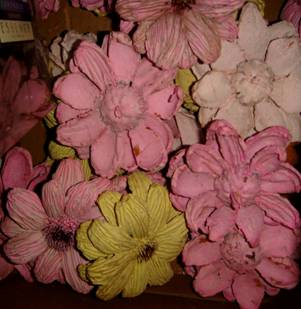
|
| Dried flowers |
|
Preservation of plant materials
There are a few methods of preserving flowers and foliage.
- Hanging upside-down: Many flowers dry best by this method. It is the easiest method and is preferable to those materials which keep their shape and do not fall apart while drying. Materials intended for drying are tied and allowed to hang upside down from string without touching each other.
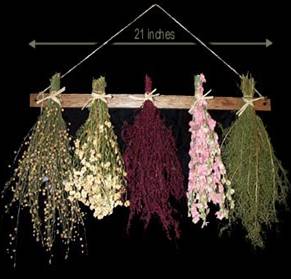
|
| Hanging upside-down |
- Burying in sand or borax: Fine and dry sand are poured to a depth of 10 cm into a box or pan. The flowers which should be dry are stripped of all foliage and may be kept upside down on the sand and then covered with a layer of sand over them. After two weeks of time, the sand may be poured off carefully and the flowers may be taken out after gently wiping them free of sand with a soft brush. They are then ready for arrangement. Borax may be used in almost the same way as sand and is a good medium for preserving materials when space is limited. Alum and silica gel are also used in the place of borax. The form of flowers are also well preserved in borax method. Candytuft, daisies, marigold, narcissus, chrysanthemum, snapdragons, sunflowers, tithonia, all roses and coleus leaves dry well in sand or borax.
|
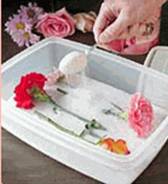
|
| Burying in silica gel |
|
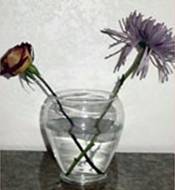
|
| Glycerin method |
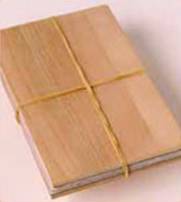
|
| Pressing between papers |
Design for dried arrangement
The same basic principles of design apply both to dried as well as fresh arrangement. Here beauty is lacking as against in some fresh flowers, design is given much important in dried arrangement. Before deciding on a design, one has to consider the composition to be a line or mass arrangement. In line arrangement, the main emphasis is a definite outline with restrained use of interesting forms of leaves, stems, buds or seed pods. On the other hand, in mass effect in colour and form.
The pattern most frequently used are the crescent, S-curve, Triangle, fan, Round, Oval, Pyramid, L-Vertical and horizontal. The other considerations viz, balance, harmony, scale, repetition, focal point, rhythum and unity are also important in dried arrangement. The focal point or center of interest, where all important lines meet is the spot where the eyes come to rest. This is a natural place for the largest flowers, the key note of the whole composition. The focal point should be in proper scale to the rest of the composition. Hydrangeas, Celosia, Magnolia blossoms make good focal points.
Colour in dried arrangement
Flowers and foliage properly dried retain much of their colour and variety in colour may be brought out by choosing correct materials. The commonly used colour blends are monochromatic, analogous, complementary and triad. When on hue with its light and dark values or tones are brought in an arrangement, it is ‘monochromatic’. When neighbouring and closely related colours, those adjacent on the colour wheel say blue and green, yellow and orange are combined it is called ‘analogous’. On the other hand, contrasted opposite on colour wheel, as green and red are combined, it is known as ‘complementary’. Three colours equidistant on the colour wheel, as yellow, blue and red are combined it is a ‘triad’. Containers made up of dull metals like copper, brass or earthern pots and wooden vessels, old lamps and three caddies also make excellent containers.
Bases: Dried arrangements are made ‘distinctive’ by keeping them over a proper base. A commercial base of round, oval or rectangular blocks of any good wood is preferred. Bases give formality and dignity. A well-proportioned base is essential for any dried arrangement. The surfaces of the base blocks may be polished to make them shining.
The kinds of mechanism to hold the materials in fresh arrangements may also be used for dried arrangement. The dust noticed on the arrangements may be cleaned gently with a small water colour brush or wiped with a slightly moistened cloth or brush. |
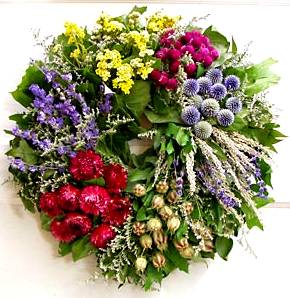
|
| Triad colour blend |
|
Source
1. http://en.wikipedia.org/wiki/Ikebana
2.http://lh3.ggpht.com/_OVtOM-JqUfA/STzS4ydbP7I/AAAAAAAAGiY /dmI9YrIzr_E/s800/Angel4.jpg
3. http://www.flower-arrangement-advisor.com/images/L_shape_fillers.jpg
4.http://www.made-in-china.com/image/2f0j00CMFtPOwISQkdM/Porcelain-Flower-Basket.jpg
5. http://www.makebe-leaves.com/top_image/Tuscany_med_top.jpg
6. http://www.fs-evergreen.com/pic/intro-p/sshape.jpg
7. http://i137.photobucket.com/albums/q228/bocasgarden/Floral%20Design/Floral-Design-123.jpg
8. http://www.gloriousfloraldesigns.com/images/IkebanaJPGO/IkebanaPinkLily.jpg
9. http://www.wise4living.com/hdarti/images/dried-arrangement.jpg
10. http://www.mauidriedflowers.com/images/dried_bamboo_lg.jpg
11. http://www.driedflowersdirect.com/art-and-craft/st5full.jpg
12. www.floristsregister.com/how_to_dry_flowers.php
13. http://www.freshflowersandgifts.com.au/shop/images/big/D23.jpg
|
|








